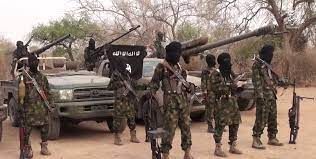A new report by Nextier has revealed that insurgency has resulted in 109 deaths from 19 violent incidents, perpetrated by Boko Haram and the Islamic State of West Africa Province (ISWAP) insurgents, in the first half of 2024 alone.
The report, titled “Nigeria’s Northeast Belt of Insurgency and the Challenge of Refugees,” urges the Federal Government to collaborate with neighboring countries and regional bodies to enhance joint border surveillance.
The report was authored by Dr. Chukwuma Okoli, an Associate Consultant at Nextier and Lecturer at the Political Science Department of Nnamdi Azikiwe University, Awka, Nigeria, and Dr. Ndu Nwokolo, a Managing Partner at Nextier and Honorary Fellow at the School of Government at the University of Birmingham, UK.
The report reads, “They identified the ‘Northeast Belt of Insurgency’ to consist of about 18 Local Government Areas (LGAs) – 10 in Borno State (Bama, Baga, Biu, Chibok, Gwoza, Kukawa, Kaga, Marte, Mongonu, Ngala), five LGAs in Adamawa State (Madagali, Michika, Mubi North, Mubi South, Maiha) and three LGAs in Yobe State (Damaturu, Gujba, Geidam); all of which run round Nigeria’s borders with Cameroon, Chad and Niger and cuts through Borno State’s borders with Yobe and Adamawa states.
“The difficult topography of most of the communities in the Northeast Belt of Insurgency makes access difficult for both the Nigerian military and humanitarian aid agencies. This has become an advantage for the insurgents who hibernate in those communities from where they launch attacks on the military and civilians.
“Data from the NextierViolent Conflict Database show that this Belt of Insurgency recorded 109 deaths arising from 19 violent incidents perpetrated by the Boko Haram and Islamic State of West Africa Province (ISWAP) insurgents in the first half of 2024 alone.
“The Nigerian government should collaborate with its neighbours under the auspices of regional bodies like the Lake Chad Basin Commission (LCBC) and Multinational Joint Task Force (MJTF) to enhance border management through joint border patrol and surveillance.”
In the report, Nextier asked the Nigerian government to identify and profile refugees entering the region and recommended the use of local vigilantes and hunters to combat insurgents.
It also urged the government to support security forces by ensuring a regular and adequate supply of required state-of-the-art ammunition.
It added, “The Nigerian government, together with development partners, should enhance the technical capacity of the National Commission for Refugees, Migrants and Internally Displaced Persons in the area of identification and profiling of refugees flowing into the Northeast. This will enable proper treatment of refugees in line with relevant international conventions and protocols.
“The government at all levels, in collaboration with development partners, should identify what makes communities in the Northeast Belt of Insurgency resilient. Mechanisms such as local informal businesses such as trading and the use of local vigilantes and hunters to combat insurgents should be strengthened.
“The state security forces should be supported by ensuring a regular and adequate supply of required state-of-the-art ammunition. The morale of the personnel on the war front should also be boosted through improved welfare packages. This will enable the security agencies to cover more ground and decimate the insurgents still hibernating in hard-to-reach areas.
“Set up a subregionalhumanitarian response mechanism involving Nigeria, Niger, Chad, and Cameroon to be coordinated by the United Nations Office for the Coordination of Humanitarian Affairs (OCHA). This will ensure persons in need have fair access to humanitarian aid without crossing national borders.”


